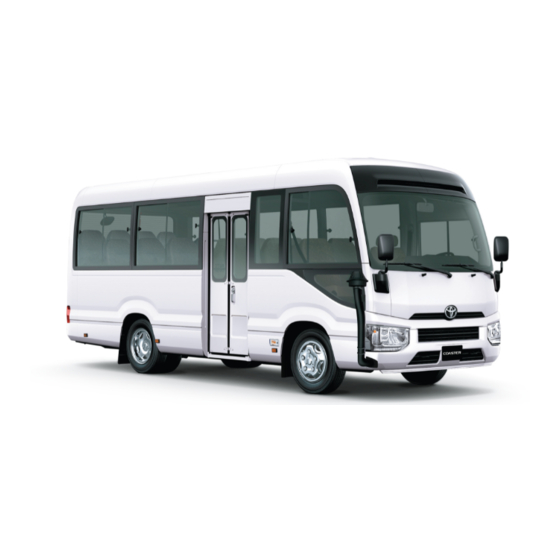
Toyota COASTER Manuals
Manuals and User Guides for Toyota COASTER. We have 1 Toyota COASTER manual available for free PDF download: Owner's Manual
Toyota COASTER Owner's Manual (484 pages)
Table of Contents
-
-
Rear19
-
-
-
Floor Mat35
-
For Safe Use
35-
Seat Belts39
-
SRS Airbags44
-
-
-
Back Doors108
-
Back Door Step113
-
Driver’s Seat116
-
-
Steering Wheel122
-
Horn122
-
-
-
Side Windows132
-
-
-
The Windows132
-
Driving
134-
Stopping135
-
-
-
Roof Rack146
-
-
Parking Brake162
-
-
Headlight Switch169
-
Fog Light Switch171
-
-
-
-
-
Brake Assist188
-
-
When Braking198
-
Delays198
-
Air Conditioning199
-
Luggage199
-
Audio System
202
-
-
-
-
Random Play216
-
Repeat Play218
-
Error Messages219
-
Lens Cleaners220
-
Compatible Media221
-
File Names221
-
Multi-Sessions222
-
ID3 and WMA Tags222
-
Extensions222
-
Playback223
-
Control Panel225
-
-
-
Play Mode List226
-
Selecting a List227
-
Selecting Songs227
-
About Ipod229
-
Ipod Functions229
-
Ipod Problems230
-
-
-
And Defogger244
-
-
Other Functions247
-
Center Outlet248
-
Air Outlets253
-
Cooler System255
-
-
-
Cup Holders265
-
Bottle Holder266
-
Auxiliary Boxes267
-
Card Holder268
-
-
-
Clock273
-
Sun Visors273
-
Power Outlet274
-
Ashtrays275
-
Tachograph276
-
Chart Cartridge277
-
Chart Records279
-
-
-
-
-
Road Conditions292
-
-
LPG Engine316
-
-
1HZ Engine319
-
1BZ-FPE Engine321
-
Engine Oil324
-
Engine Coolant329
-
Battery331
-
Caution Symbols331
-
Battery Exterior331
-
Washer Fluid334
-
Adblue340
-
Tires348
-
Wheels353
-
Wheel Selection353
-
Removal Method355
-
Light Bulbs362
-
Front Fog Lights372
-
LED Lights379
-
-
-
-
Plated Portions283
-
-
-
Visible Symptoms392
-
Audible Symptoms392
-
-
-
Warning Buzzer400
-
-
-
-
Dimensions453
-
Oil Viscosity463
-
Oil Grade464
-
Ignition System470
-
-
Fuel Information476
-
-
Customization
478 -
Appendix
480-
What to Do if480
Advertisement
